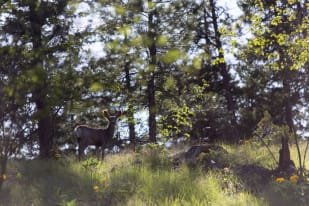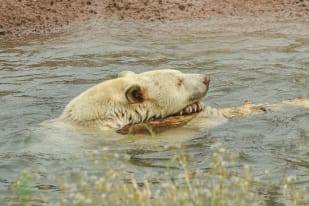The Salmon Run in Kamloops
Every fall, Kamloops offers several locations where visitors can witness sockeye salmon travelling upstream to complete their life cycle. The event draws nature watchers, photographers, and those interested in the life processes of Pacific salmon. Kamloops' rivers and lakes form critical parts of the salmon migration routes, making the city a key point for viewing one of British Columbia's most important wildlife events.
The salmon run is not only about the fish. It impacts entire ecosystems. Birds, bears, and smaller predators depend on the salmon for food, and the nutrients left behind after spawning help fertilize riverside forests. In Kamloops, accessible parks and conservation areas allow people to observe this seasonal movement with minimal disruption to the environment.
The Life and Journey of Pacific Salmon
Pacific salmon start life in freshwater streams before heading to the ocean where they spend most of their adult years. After growing to maturity, they return to their natal freshwater rivers to spawn. Sockeye salmon, the main species featured during Kamloops' fall run, are capable of traveling more than 4,000 kilometres from the Pacific Ocean back to spawning grounds like the Adams River.
The return journey demands strength and precision. Salmon swim against powerful currents, leap over natural obstacles, and navigate complex river systems using environmental cues. After spawning, their bodies break down, feeding not only the aquatic system but surrounding forests and wildlife.
Tsú́tswecw Provincial Park
Tsú́tswecw Provincial Park, formerly known as Roderick Haig-Brown Provincial Park, is one of the most recognized locations to watch the salmon run near Kamloops. Located about 40 minutes east of the city along the Adams River, the park features trails and wooden viewing platforms that give close access without damaging the habitat.
During dominant years in the four-year sockeye cycle, millions of salmon arrive at Tsú́tswecw to spawn. The park becomes a centre of activity, including the "Salute to the Sockeye" festival hosted by the Adams River Salmon Society. Alongside salmon viewing, visitors can see evidence of ancient Secwepemc First Nation habitation, including pit houses and other archaeological features.
Banana Island Provincial Park
Banana Island Provincial Park sits about 35 kilometres east of Kamloops on the South Thompson River. While direct access to the small protected island is restricted to protect sensitive wildlife, the surrounding riverbanks provide clear views of salmon moving through the waterways.
The island's environment draws more than just salmon. Osprey, bald eagles, and other bird species gather during the salmon run, creating strong opportunities for birdwatching as well as salmon observation. The lack of developed facilities on Banana Island supports wildlife conservation by reducing human impact.
Adams Lake Provincial Park
Adams Lake Provincial Park includes several sites along the east and west sides of Adams Lake. The park's beaches and forests offer quieter viewing opportunities compared to Tsú́tswecw, although they still see salmon activity, particularly at Spillman Beach and other accessible areas.
While the salmon runs at Adams Lake are not as concentrated as those at Adams River, visitors who are prepared for a more self-directed experience can spot spawning salmon and enjoy longer stays surrounded by natural settings. Campsites, boat launches, and hiking trails around the lake provide multiple access points for observation.
Timing Your Visit
The salmon run around Kamloops typically starts in late September and carries into mid-October. Specific timing varies depending on water temperatures and river conditions. For the largest sockeye salmon returns, planning around dominant years in the four-year cycle yields the most activity. Dominant years, such as 2014 and 2018, brought millions of salmon back to the Adams River.
During sub-dominant years, significant but smaller runs take place, while post-subdominant and pre-dominant years offer quieter but more intimate viewing opportunities. It is important to check local park updates and conditions ahead of time to know what to expect during your visit.
Preparing for the Experience
Visitors should come prepared to experience the salmon run respectfully and safely. Polarized sunglasses help reduce water glare, making it easier to see salmon swimming upstream. Binoculars can aid in spotting wildlife from a distance. Wearing sturdy footwear is necessary, as trails can be muddy or uneven in fall conditions.
It is important to stay on marked trails and avoid walking in or near the river. Dogs must be leashed at all times and kept away from the water to protect spawning fish. Visitors should not throw objects into the river or attempt to interact with the fish.
Wildlife is active during the salmon run season. Bears, in particular, are attracted to spawning grounds. Observers should maintain a safe distance and follow all wildlife safety guidelines, including carrying bear spray and making noise to avoid surprising animals.
Closing Thoughts
Kamloops provides strong opportunities for those who want to experience the salmon run firsthand. Tsú́tswecw Provincial Park, Banana Island, and Adams Lake each offer different ways to engage with the event, from large-scale sockeye gatherings to quieter riverbank observations.
By preparing appropriately and respecting the habitats, visitors can witness a natural phenomenon that has shaped the land, culture, and ecosystems of British Columbia for thousands of years.




